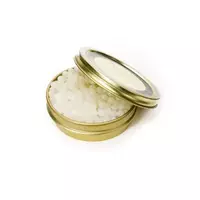Snail caviar

Did you know that not only fish, but also other amphibian inhabitants of planet Earth are throwing caviar? Recently, rare types of food, including caviar, have become increasingly popular. Nowadays, you will not surprise anyone with red or black caviar, these once delicatessen products are considered commonplace in the modern culinary tradition. Chefs do not stop looking for original taste and fragrant combinations, and food manufacturers try to periodically delight sophisticated connoisseurs with exclusive novelties.
In the past few years, foodies around the world have dreamed of tasting snail, frog or cuttlefish caviar. Unusual caviar is not only expensive, but also a hard-to-reach product. The price of a 100 gram jar of snail caviar in our latitudes reaches several hundred US dollars. Therefore, snail caviar refers to expensive and rare food products available to not every average resident of our latitudes. True, once other types of caviar were considered a special food product, which was served exclusively on festive or special occasions in a person's life.
The French were the first to use grape snail caviar in cooking. This is not surprising at all, given the love French culinary experts have for unusual taste combinations and foods. Take the frog's feet, another French know-how that, in a matter of years, won over most foodies around the world with its distinctive delicate taste. The first grape snail farm was opened in the late 80s of the last century in France.
Well-known foodie and culinary enthusiast Jean-Pierre Faranca became the discoverer of a new type of caviar. It takes remarkable knowledge and opportunity to begin the process of nurturing snails on an industrial scale. The unprecedented high cost of snail caviar is due to the peculiarities of the life cycle of a living organism. The fact is that grape snails deposit caviar only twice a year. Faranca's entire snail farm produces only a couple of kilograms of delicacy in a year. One individual grape snail lays only 3 grams of caviar at a time. It is not difficult to calculate how many snails it takes to get a kilogram of caviar.
Currently, snail caviar is produced in America and Japan. However, only the French product is considered a standard of taste and quality. Snail caviar resembles small pearls of neat round shape and white in appearance. The taste of snail caviar is difficult to describe in a nutshell. Exquisite and refined - perhaps here are two of the most faithful epithets that apply to the taste of grape snail caviar.
Usually, additional ingredients are added to the snail roe to give the product an oily consistency. Grape snail caviar is served as a snack or used as an ingredient to make exotic dishes. Snail caviar producers justify the shockingly high price of the product by the fact that to produce only 100 grams of caviar product, you need to manually (in order not to damage the shape of the eggs in any way) process 260 clutches of grape snail.
snail roe 90 kCal
Energy value of snail caviar (Ratio of proteins, fats, carbohydrates - ju):
Proteins: 16.1 (~ 64 kCal)
Fats: 1.4 g (~ 13 kCal)
Carbohydrates: 2g (~ 8kCal)
Energy ratio (bj | y): 72% | 14% | 9%
 Español
Español Français
Français Português
Português Русский
Русский 简体中文
简体中文 繁體中文
繁體中文 日本語
日本語 한국어
한국어 العربية
العربية Türkçe
Türkçe Қазақ
Қазақ Deutsch
Deutsch Italiano
Italiano Українська
Українська
